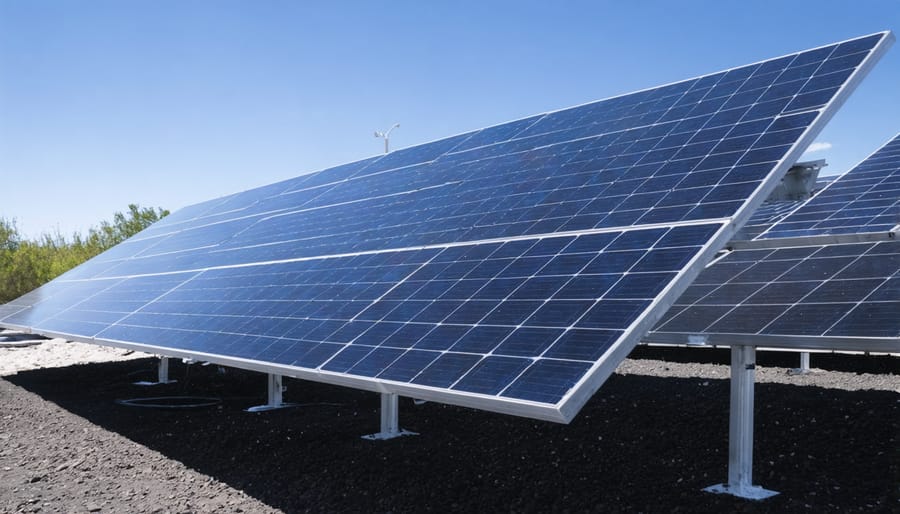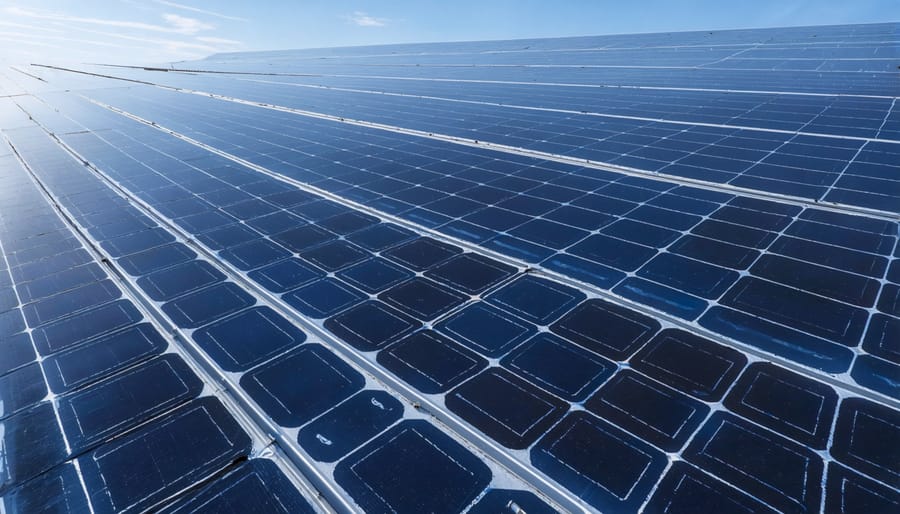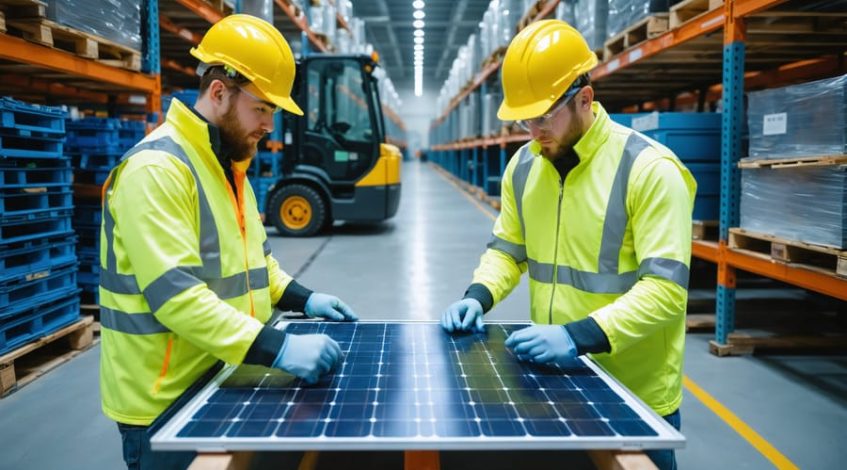**Establish formal agreements with certified recycling facilities** that specialize in processing end-of-life solar panels, ensuring your decommissioned photovoltaic systems are handled according to EU WEEE Directive standards and circular economy principles.
**Engage with manufacturer take-back programs** where solar panel producers commit to recovering and recycling their products at end-of-life, reducing your liability while supporting closed-loop supply chains that recover up to 95% of valuable materials including silicon, glass, and aluminum.
**Form collaborative relationships with waste management companies** experienced in solar infrastructure to create economically viable recycling pathways, as individual facilities typically lack the volume needed to justify dedicated recycling operations while collective partnerships reduce per-panel processing costs by 40-60%.
**Document partnership commitments in procurement contracts** by requiring suppliers to demonstrate verifiable recycling partnerships before installation, protecting your organization from future disposal liabilities as the solar industry faces an estimated 78 million tonnes of panel waste by 2050.
Recycling partnerships transform end-of-life solar management from a compliance burden into a strategic advantage. These collaborative arrangements between solar asset owners, manufacturers, recyclers, and waste management specialists ensure photovoltaic systems complete their lifecycle responsibly while recovering valuable materials. For commercial operations managing multi-megawatt installations, establishing these partnerships today prevents costly disposal challenges tomorrow while demonstrating environmental leadership that resonates with stakeholders and regulatory frameworks alike.
The Mounting Challenge: Solar Panel Waste on the Horizon

Understanding PV Panel Composition and Recyclability
Solar panels are sophisticated assemblies containing multiple valuable materials that merit recovery rather than disposal. A typical photovoltaic module consists of approximately 76% glass, 10% polymer-based encapsulants and backsheets, 8% aluminum framing, 5% silicon wafers, and 1% copper wiring and other metals, including trace amounts of silver.
The glass component, while bulky, has straightforward recycling pathways and significant market value when properly processed. Silicon cells, the panels’ power-generating core, contain high-purity semiconductor material that can be recovered and reintroduced into manufacturing supply chains. The aluminum frames represent another readily recyclable commodity with established markets.
More valuable—and technically challenging—are the trace metals embedded within solar cells. Silver, used in electrical contacts, commands premium pricing but requires specialized extraction processes. Copper wiring, junction boxes, and electrical components also retain substantial recovery value. Even the polymer materials, though more difficult to recycle, are increasingly targeted by advanced processing facilities.
This material composition presents a clear business case for specialized recycling infrastructure. Standard municipal waste streams lack the technical capacity to efficiently separate and recover these components, resulting in valuable materials entering landfills. Purpose-built solar recycling facilities employ mechanical, thermal, and chemical processes to achieve recovery rates exceeding 95% for certain materials. Establishing partnerships with these specialized recyclers ensures that end-of-life panels become resource streams rather than waste burdens, supporting both environmental objectives and circular economy principles that increasingly influence procurement decisions and regulatory compliance requirements.

What Recycling Partnerships Actually Mean for the Solar Industry
Manufacturer Take-Back Programs
Leading photovoltaic manufacturers are increasingly recognizing their environmental responsibility by establishing comprehensive take-back programs in partnership with specialized recycling facilities. These initiatives create closed-loop systems where end-of-life panels return to manufacturers or their designated recycling partners, ensuring materials are recovered and reintegrated into new production cycles.
First Solar pioneered this approach with its global take-back program, which has successfully recycled over 2 billion panels since 2006. Their partnership with recycling specialists enables recovery of up to 95% of semiconductor materials, which are then reused in manufacturing new modules. This closed-loop model significantly reduces raw material costs while demonstrating corporate environmental stewardship.
European manufacturers like Meyer Burger and REC Group have established similar frameworks, partnering with certified recycling facilities across multiple countries to provide convenient collection points for commercial installations. These partnerships typically include pre-funded recycling fees embedded in the initial panel purchase, eliminating unexpected disposal costs for facility managers.
For business owners and government officials planning large-scale installations, selecting manufacturers with established take-back programs offers substantial advantages. These arrangements provide clear end-of-life solutions, ensure regulatory compliance, and may qualify for environmental certifications that enhance corporate sustainability profiles. Additionally, guaranteed recycling pathways protect against future liability and disposal cost uncertainties.
When evaluating solar panel suppliers, decision-makers should request detailed information about manufacturer take-back partnerships, including geographic coverage, recycling rate certifications, and financial mechanisms ensuring long-term program viability. This due diligence supports both environmental objectives and sound financial planning for the complete lifecycle of your solar investment.
Industry Consortiums and Collective Action
Industry consortiums represent a powerful model for accelerating solar recycling capabilities through shared investment and standardized practices. The Solar Energy Industries Association (SEIA) has established a national PV recycling program in the United States, connecting manufacturers, installers, and certified recyclers to create accessible end-of-life solutions. Member companies collectively fund recycling research and infrastructure development while establishing industry-wide best practices.
In Europe, the PV Cycle consortium demonstrates how multi-company collaboration achieves scale. This non-profit association manages collection and recycling operations across the continent, processing over 30,000 tonnes of photovoltaic waste annually. Members share the financial burden of compliance with WEEE Directive requirements while benefiting from standardized processes and reduced per-unit costs.
The Silicon Valley Toxics Coalition brings together technology companies, environmental organizations, and solar manufacturers to develop sustainable electronics recycling protocols applicable to PV systems. Their collective action model addresses both technical challenges and regulatory compliance, particularly regarding hazardous materials management.
These partnerships extend beyond recycling to encompass broader supply chain integration, creating closed-loop systems that recover valuable materials for new panel production. For facility managers and business owners, participating in established consortiums offers immediate access to compliant recycling solutions without requiring substantial capital investment in proprietary infrastructure. The collective approach distributes costs across multiple stakeholders while accelerating the development of circular economy practices that reduce long-term operational expenses and enhance corporate sustainability credentials.

Real-World Partnership Models That Work
European WEEE Directive Success Stories
The European Union’s Waste Electrical and Electronic Equipment (WEEE) Directive has catalyzed transformative partnerships in the solar industry, establishing a regulatory framework that mandates extended producer responsibility (EPR) for photovoltaic modules. Since 2012, when solar panels were included under the WEEE Directive, manufacturers have been legally required to finance the collection, treatment, and recovery of end-of-life panels—a mandate that has driven unprecedented collaboration models.
PV CYCLE, Europe’s leading solar panel recycling initiative, exemplifies this success. The non-profit organization brings together over 200 panel manufacturers, importers, and distributors who collectively fund recycling infrastructure across 15 European countries. Through this consortium approach, member companies share logistical networks and processing facilities, achieving economies of scale that individual manufacturers couldn’t attain independently. The results speak volumes: PV CYCLE has collected and recycled over 140,000 tonnes of solar panels, with recovery rates exceeding 95%.
Another notable case involves Deutsche Solar’s partnership with Veolia, where the manufacturer integrated take-back schemes directly into their product warranties. Customers receive prepaid collection services, while Veolia’s specialized facilities recover valuable materials including silver, copper, and silicon. This closed-loop model has recovered approximately €15 million worth of materials annually while ensuring compliance with stringent industry standards.
These partnerships demonstrate how regulatory frameworks can stimulate innovation rather than simply imposing costs. By pooling resources and expertise, European solar companies have transformed compliance obligations into competitive advantages—establishing recycling infrastructure that not only meets environmental mandates but also recovers valuable materials, reduces landfill costs, and strengthens brand reputation among sustainability-focused commercial clients. This regulatory-driven collaboration model offers valuable lessons for markets worldwide as solar installations approach end-of-life phases.
The Business Case: Why Commercial Solar Operators Should Care
Risk Mitigation and Future-Proofing Your Investment
Participating in recycling partnerships provides crucial protection against an evolving regulatory landscape while strengthening your organization’s market position. As governments worldwide tighten waste management requirements and extended producer responsibility schemes, businesses with established recycling frameworks avoid costly compliance scrambles and potential penalties.
The financial benefits extend beyond compliance. Recycling partnerships shield organizations from volatile disposal costs, which have increased substantially as landfill capacity diminishes. Consider a Queensland logistics facility that reduced its solar waste liability exposure by 85% through a structured recycling agreement, converting potential future costs into predictable, manageable fees. This approach mirrors the strategic value of future-ready partnerships that anticipate market shifts.
These collaborations also enhance your sustainability credentials—increasingly critical for tender responses, stakeholder expectations, and ESG reporting. Organizations demonstrating circular economy practices gain competitive advantages in procurement processes and attract environmentally conscious customers. A manufacturing company in Victoria secured three major contracts specifically citing their comprehensive solar recycling program as a differentiating factor.
Furthermore, partnerships provide access to evolving technologies and recovery processes, ensuring your waste management strategy remains current as recycling methods improve. This adaptability protects against technological obsolescence and maximizes material recovery value over time, transforming environmental responsibility into a strategic business asset rather than a compliance burden.
Recovering Value from End-of-Life Assets
End-of-life solar panels contain valuable materials including silicon, silver, copper, aluminum, and glass—components that represent significant economic value when properly recovered. Strategic recycling partnerships transform decommissioning from a pure cost center into an opportunity for material value reclamation.
Leading recycling partners employ advanced separation technologies that can recover up to 95% of materials from retired panels. Silicon wafers, for instance, can be purified and reintegrated into new panel manufacturing, while precious metals like silver command substantial market prices. Aluminum frames and junction boxes offer immediate resale value to metal refiners.
Forward-thinking facility managers are negotiating recycling agreements that offset decommissioning expenses through material revenue sharing. Some partnerships provide upfront credits against future recycling services, improving project economics from day one. Large-scale operators with multi-megawatt installations have secured contracts where material recovery revenues reduce net disposal costs by 40-60%.
These partnerships also create predictable budget forecasting for asset lifecycle management. Rather than facing uncertain end-of-life liabilities, organizations can establish clear residual value expectations, improving financial modeling for solar investments. Additionally, demonstrating material recovery to stakeholders strengthens sustainability credentials while generating tangible returns—a compelling combination for ROI-focused decision-makers evaluating circular economy approaches to solar asset management.
Building Circular Economy Infrastructure Through Collaboration

Technology Innovation Through Joint Development
Collaborative research and development initiatives between solar manufacturers, recycling specialists, and technology providers are driving breakthrough innovations in photovoltaic waste management. These partnerships pool resources and expertise to tackle the complex challenge of efficiently recovering valuable materials from end-of-life solar panels.
Advanced separation technologies represent a critical focus area for joint development efforts. Traditional mechanical processing methods often struggle to separate silicon, silver, copper, and other precious materials without contamination. Through shared investments, partners are developing thermal, chemical, and hybrid processes that achieve recovery rates exceeding 95% for key materials—significantly higher than conventional recycling methods. One European consortium recently demonstrated a novel delamination technique that preserves silicon wafer integrity, enabling direct reuse rather than downcycling.
Processing efficiency improvements are equally significant. Joint development programs leverage automation, artificial intelligence, and robotics to reduce labor costs and increase throughput. A prominent example involves public-private partnerships that have deployed AI-powered sorting systems capable of identifying panel types and optimizing processing routes in real-time, reducing handling time by 40%.
Material recovery innovations extend beyond basic component separation. Partnerships are developing closed-loop systems where recovered silicon and metals meet semiconductor-grade specifications, creating genuine circular economy pathways. This technical advancement transforms recycling from waste management into resource security—particularly valuable given ongoing supply chain pressures affecting the solar industry. The collective investment in R&D ultimately benefits all stakeholders through improved economics and environmental outcomes.
What to Look for in a Recycling Partner
Selecting the right recycling partnership requires careful evaluation of several critical factors to ensure compliance, cost-effectiveness, and alignment with your sustainability objectives.
**Certification and Compliance Standards**
Verify that potential partners hold recognized certifications such as R2 (Responsible Recycling) or e-Stewards, which demonstrate adherence to environmental and safety protocols. For European operations, ensure compliance with the WEEE Directive requirements. Request documentation showing proper permits, insurance coverage, and environmental management system certifications like ISO 14001. These credentials indicate a partner’s commitment to responsible processing and reduce your liability exposure.
**Service Scope and Technical Capabilities**
Assess whether the partner handles the full spectrum of PV components—from crystalline silicon panels to thin-film technologies and inverters. Leading partners should offer comprehensive services including collection logistics, secure data destruction for smart inverters, material recovery processes, and proper handling of hazardous substances like cadmium or lead. Understanding their processing methodology ensures materials are genuinely recycled rather than merely landfilled.
**Geographic Coverage and Logistics**
Evaluate the partner’s operational footprint relative to your facilities. Partners with regional collection networks reduce transportation costs and carbon emissions associated with decommissioning projects. Inquire about minimum volume requirements, pickup scheduling flexibility, and whether they provide on-site decommissioning services for large-scale installations.
**Reporting and Documentation**
Robust reporting capabilities are essential for compliance documentation and ESG disclosures. Partners should provide certificates of recycling, material recovery rates, environmental impact metrics, and tracking systems that create transparent audit trails. This documentation demonstrates regulatory compliance and supports sustainability reporting to stakeholders and investors.
**Key Questions to Ask**
Before finalizing any partnership, request case studies from similar-sized installations, clarify all fee structures including potential hidden costs, understand material ownership rights for recovered commodities, and establish clear timelines for processing. Ask about their downstream vendors to ensure recovered materials enter legitimate recycling streams rather than export markets with questionable environmental standards.
The solar industry stands at a pivotal moment where end-of-life management is transitioning from an afterthought to a strategic imperative. As the first generation of large-scale photovoltaic installations approaches retirement, proactive engagement with recycling partnerships has evolved from a sustainability checkbox into a genuine competitive advantage. Organizations that establish these relationships now position themselves ahead of tightening regulations, demonstrate environmental leadership to stakeholders, and secure predictable decommissioning costs that protect their bottom line.
The circular economy in solar is rapidly maturing, driven by technological innovation, regulatory frameworks like the EU’s WEEE Directive, and growing recognition that valuable materials locked in aging panels represent both economic opportunity and environmental responsibility. Industry leaders who have already integrated recycling partnerships into their operational planning report smoother project lifecycles, enhanced corporate sustainability profiles, and improved relationships with regulatory bodies and community stakeholders.
For businesses currently operating solar installations or planning new deployments, the time to evaluate end-of-life strategies is now—not when decommissioning deadlines loom. Engaging with certified recycling partners, understanding your contractual obligations, and incorporating lifecycle planning into project feasibility assessments ensures your organization remains compliant, competitive, and aligned with the solar industry’s sustainable future. The question is no longer whether to address photovoltaic recycling, but how strategically your organization will approach this emerging standard. Those who act decisively today will lead tomorrow’s circular solar economy.

